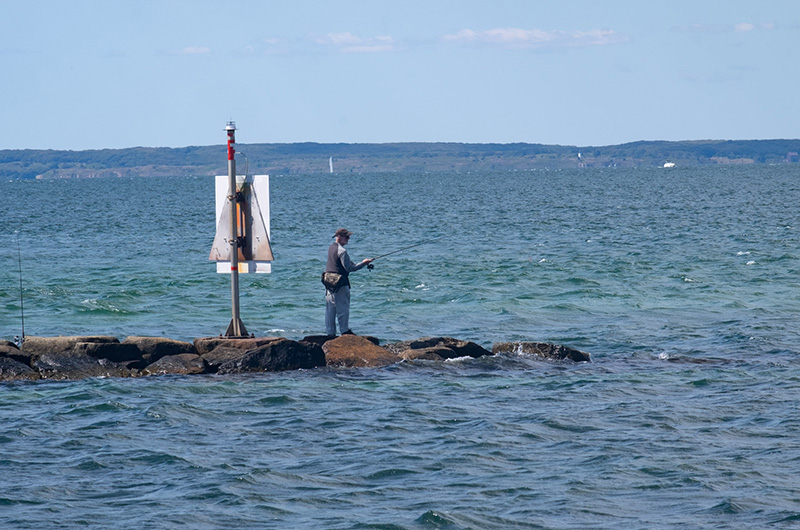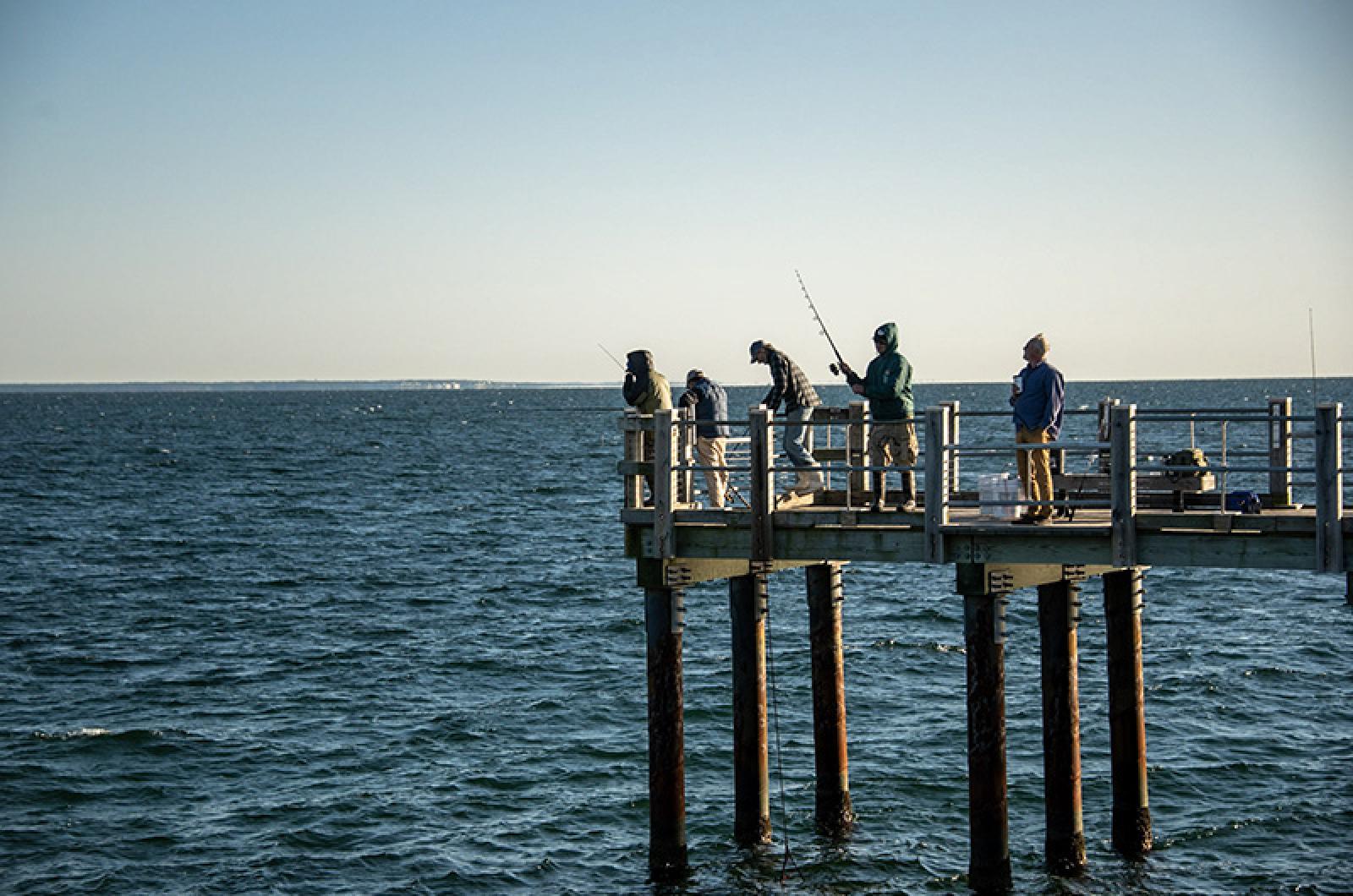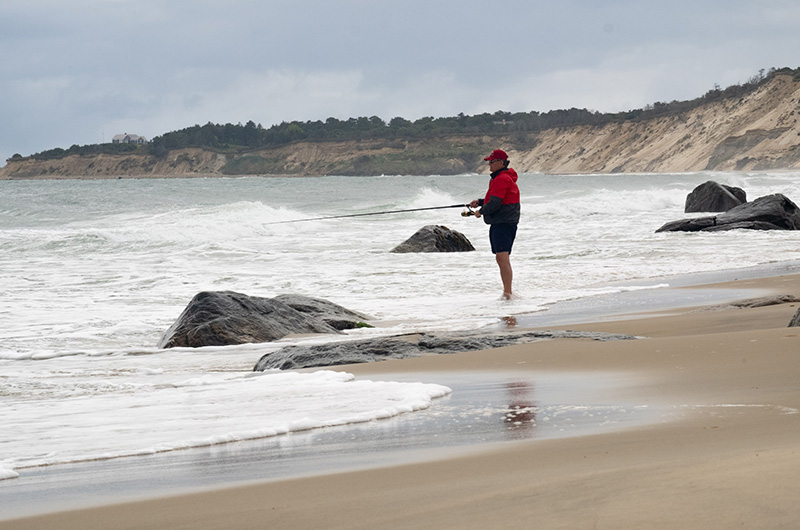It is five days into the 74th annual Striped Bass and Bluefish Derby and all over the Island, fishermen are hauling their packs of tackle along the shoreline or heading out in boats and then converging each morning and night at the derby headquarters in Edgartown to weigh in their catch.
In this early stage, the leaderboards feature many blank spots still to be chalked in. And of the categories that have been claimed, many are believed to be placeholders for when the big fish arrive in the coming weeks.
False albacore are the signature fish of the early derby season. A 7.73 pounder, caught by Max Davies, was the first fish to cross the scale on Sunday morning as the derby got underway.
As of Thursday, Westley L. Wlodyka’s 12.96 pound false albacore caught from boat and Brian Gracie’s 11.43 pound false albacore landed from shore, on the first night of the derby, lead the category. In 2016, the false albacore winners weighed in at 11.77 pounds from boat and 10.79 pounds from shore. But size has been climbing in recent years and last year a 15.75 pounder caught from a boat won the derby.
“All categories are still ripe for the picking,” said derby chairman Joe El-Deiry.
Fishing the derby requires straddling a delicate line between fishing etiquette and fierce competition as anglers battle for bragging rights, along with the grand prizes, a 2019 Subaru Impreza and a 19-foot Cape Codder fishing boat.
Wednesday morning, fishermen were lined up shoulder to shoulder on each side of the Menemsha channel as the slack tide began to turn out, flushing hoards of baitfish out of the harbor to be devoured by schools of false albacore. And in a similar frenzy as the fish, anglers crossed over lines and swirled around each other in a tangled dance as a strong northeast wind hurled waves against the rocks.
But anglers weren’t the only ones competing for fish.
“As soon as the line got tight I saw this seal,” Walter Greene said, after he hooked into his first albacore of the day. “I thought he didn’t care, but I felt the fish going crazy on the line. He chased the fish right up to the rocks and when I landed it its tail was all nipped. [The seal] just sat there, bobbing in the water and looking at me, like ‘hey, you took my fish.’”
As fishermen compete with each other, and seals, to land false albacore, bonito compete with false albacore to get their fair share of baitfish. In late August there was a two-week long run of bonito through the Menemsha channel, but the false albacore are now hugging up against parts of the north shore and Edgartown.
“Albies are the bullies,” said Wes Stokes as he weighed in his own false albacore at derby headquarters. “They’re a similar species and feed on the same bait. But albies are stronger and muscle the bonito offshore.”
As of Thursday morning, 1,600 pounds of fish had been weighed in across the four categories. Only 150 of those pounds have been bonito. And of that 150 pounds, only 10 pounds, two fish total, have been landed from shore.

Richard Mann currently leads the category with 5.16 pound bonito caught from shore, while Jonathan Mayhew leads with an 8.39 pound bonito brought in from boat.
Mr. Mayhew said he had a unique competitor in his hunt to find his derby-leading bonito.
Mr. Mayhew had been searching for bonito in his boat, Skillie, with his four-pawed fishing companion, Squibby, for two days before he decided to venture out into deeper water. His search brought him about one-mile off Squibnocket Point on Tuesday morning. He had three lines in the water when he saw the first one go tight, then the second and then the third.
“I was kind of going crazy trying to keep the other two on while I was reeling in the first,” he said. “I pulled the first one on board, four pounder. Then I pulled up the second, about six pounds. But when I got a hold of the third one, he buckled down hard and the line went running.”
Mr. Mayhew knew it felt too big to be a bonito and was gearing up to fight what he thought might be a huge striped bass. His line had run about 30 yards when the fish decided to breach, revealing what he described as a 2,500 to 3,000 pound Great White Shark with a four-foot tail.
His seven-foot rod with 60 pound test line didn’t put up much of a fight, Mr. Mayhew said, before the line snapped and the shark took off with his bonito.
“Derby winner? More like derby loser,” he said. “It’s competitive out there, I just didn’t think it would be a shark I was competing with.”








Comments
Comment policy »